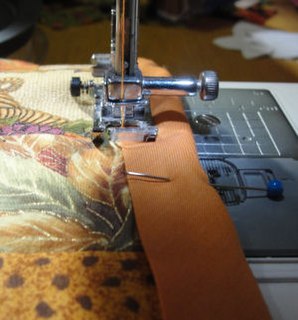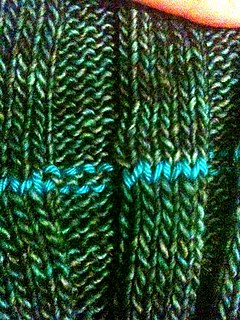 W
WIn sewing, binding is used as both a noun and a verb to refer to finishing a seam or hem of a garment, usually by rolling or pressing then stitching on an edging or trim (sewing).
 W
WA coverstitch is formed by two or more needles which add straight stitches to the fabric and a looper thread on the opposite side of the fabric that zig-zags between the straight stitches. A coverstitch results in parallel lines of straight stitches on one side of the fabric and an overcast stitch on the reverse side. It is widely used in garment construction, particularly for attaching trims and flat seaming where the raw edges can be finished in the same operation as forming the seam.
 W
WDarts are folds and sewn into fabric to take in ease and provide shape to a garment, especially for a woman's bust. They are used frequently in all sorts of clothing to tailor the garment to the wearer's shape, or to make an innovative shape in the garment. Fabric may be thought of as flat, and a dart has the effect of removing a wedge shaped piece and pulling the edges of that wedge together to create a shallow cone. This effect can be seen quite easily with a paper pattern by pulling together the edges of a dart intake as it would be sewn. Since fabric is generally more flexible than paper the fabric will shift around the apex of the cone and form a softer, but still curved, shape. In a garment a dart ends in a point at a full area of the body.
 W
WFelled seam, or flat-fell seam, is a seam made by placing one edge inside a folded edge of fabric, then stitching the fold down. The fold encases the raw edges protects them from fraying. The fold may be secured with a topstitch or a whipstitch. It is useful for keeping seam allowances flat and covering raw edges.
 W
WIn knitting, grafting is the joining of two knitted fabrics using yarn and a needle in one of three types of seams:selvage-to-selvage seam, selvage-to-end ("wales") seam, or end-to-end ("wale-to-wale") seam.
 W
WAn overlock is a kind of stitch that sews over the edge of one or two pieces of cloth for edging, hemming, or seaming. Usually an overlock sewing machine will cut the edges of the cloth as they are fed through, though some are made without cutters. The inclusion of automated cutters allows overlock machines to create finished seams easily and quickly. An overlock sewing machine differs from a lockstitch sewing machine in that it uses loopers fed by multiple thread cones rather than a bobbin. Loopers serve to create thread loops that pass from the needle thread to the edges of the fabric so that the edges of the fabric are contained within the seam.
 W
WPrincess seams are long rounded seams sewn into women's blouses or shirts to add shaping or a tailored fit to closely follow a woman's shape. They are sewn into the front and/or back of a shirt, and extend from the waist up to the arms. Princess seams are distinct from darts in that they form a continuous line and are a full seam. Darts, on the other hand, are folds sewn into the clothing to shape the resultant garment.
 W
WIn sewing, a seam is the join where two or more layers of fabric, leather, or other materials are held together with stitches. Prior to the invention of the sewing machine, all sewing was done by hand. Seams in modern mass-produced household textiles, sporting goods, and ready-to-wear clothing are sewn by computerized machines, while home shoemaking, dressmaking, quilting, crafts, haute couture and tailoring may use a combination of hand and machine sewing.
 W
WSeam allowance is the area between the fabric edge and the stitching line on two pieces of material being sewn together. Seam allowances can range from 1⁄4 inch (6.4 mm) wide to as much as several inches. Commercial patterns for home sewers have seam allowances ranging from 1⁄4 to 5⁄8 inch.
 W
WTwill tape or twilled tape is a flat herringbone twill-woven fabric tape or ribbon of cotton, linen, polyester, or wool. It may be used in sewing and tailoring to reinforce seams, make casings, bind edges, and make sturdy ties for closing garments. Twill tape is also used in theatre to tie curtains, cable and scenery to various objects, or to tie cable coils so that they do not unroll.